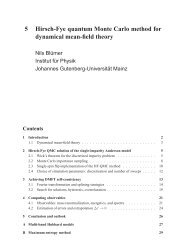Hubbard Model for Asymmetric Ultracold Fermionic ... - KOMET 337
Hubbard Model for Asymmetric Ultracold Fermionic ... - KOMET 337
Hubbard Model for Asymmetric Ultracold Fermionic ... - KOMET 337
Create successful ePaper yourself
Turn your PDF publications into a flip-book with our unique Google optimized e-Paper software.
Summary and OutlookIn this thesis we have analyzed different <strong>for</strong>ms of asymmetric <strong>Hubbard</strong> models whichcan be used to describe ultracold asymmetric Fermi-mixtures. We have diagonalized theHartree-Fock Hamiltonian (U < 0) <strong>for</strong> superfluid phases <strong>for</strong> both asymmetric hopping andspin-dependent chemical potentials and we have derived the self-consistency equations.At symmetric hopping we have rigorously shown, which solutions the self-consistencyequations may have, and we have implemented an algorithm, which respects these properties,in order to solve the self-consistency equations. Within the local density approximation(LDA) we have shown that, at T = 0 in unbalanced Fermi-mixtures in a parabolic potential,phase separation takes place. A superfluid non-magnetized phase and a non-superfluidmagnetized phase were found. The third phase predicted as possible by our analytical calculationsnever minimized the grand potential and was there<strong>for</strong>e not thermodynamically stableat T = 0.For asymmetric hopping we presented arguments, why CDW phases in translationallyinvariant systems can be neglected, and we restricted consideration to superfluid phases. AtT = 0 and away from half filling we found both magnetized and non-magnetized superfluidphases. The critical temperatures at half filling were calculated numerically as a function ofthe hopping asymmetry.Finally we analyzed the <strong>Hubbard</strong> Hamiltonian with spin-dependent hopping at strong coupling<strong>for</strong> both attractive and repulsive interaction. As a result of second order perturbationtheory we obtained effective models <strong>for</strong> the strong coupling limit. We derived ab anisotropicH XXZ -Heisenberg model <strong>for</strong> repulsive interaction at half filling, which reduces to the isotropicHeisenberg model in the <strong>Hubbard</strong> model limit and to an Ising model in the Falicov-Kimballmodel limit. For the attractive model at strong coupling with an even number of fermions,we derived a hard-core boson model with nearest-neighbor hopping and nearest-neighbor repulsiveinteraction <strong>for</strong> the bosons.In this thesis we per<strong>for</strong>med numerical calculations in the weak coupling limit at Hartree-Focklevel, and we derived effective models in the strong coupling limit. Since, <strong>for</strong>ultracold quantum gases, experimentalists are able to tune the relative interaction strength,weak coupling limit calculations may be very useful. Yet, on the other hand, it is importantto understand the physics beyond the weak coupling limit, so that the application ofnon-perturbative methods, <strong>for</strong> example DMFT or QMC, to asymmetrical <strong>Hubbard</strong> models isindispensible <strong>for</strong> reaching the intermediate interaction regime.In order to treat the trapping potential we used the LDA. Instead of using the LDA<strong>for</strong>malism,it is possible to treat the parabolic potential exactly by restricting to finite-sizelattices, where the size of the lattices may be estimated by the LDA-results. This methodis especially useful <strong>for</strong> situations in which the LDA breaks down, <strong>for</strong> small particle numbersor <strong>for</strong> a parabolic potential that varies fast in space. The exact treatment of the parabolicpotential in combination with non-perturbative treatment of the interaction is also of greatinterest, of course.57













